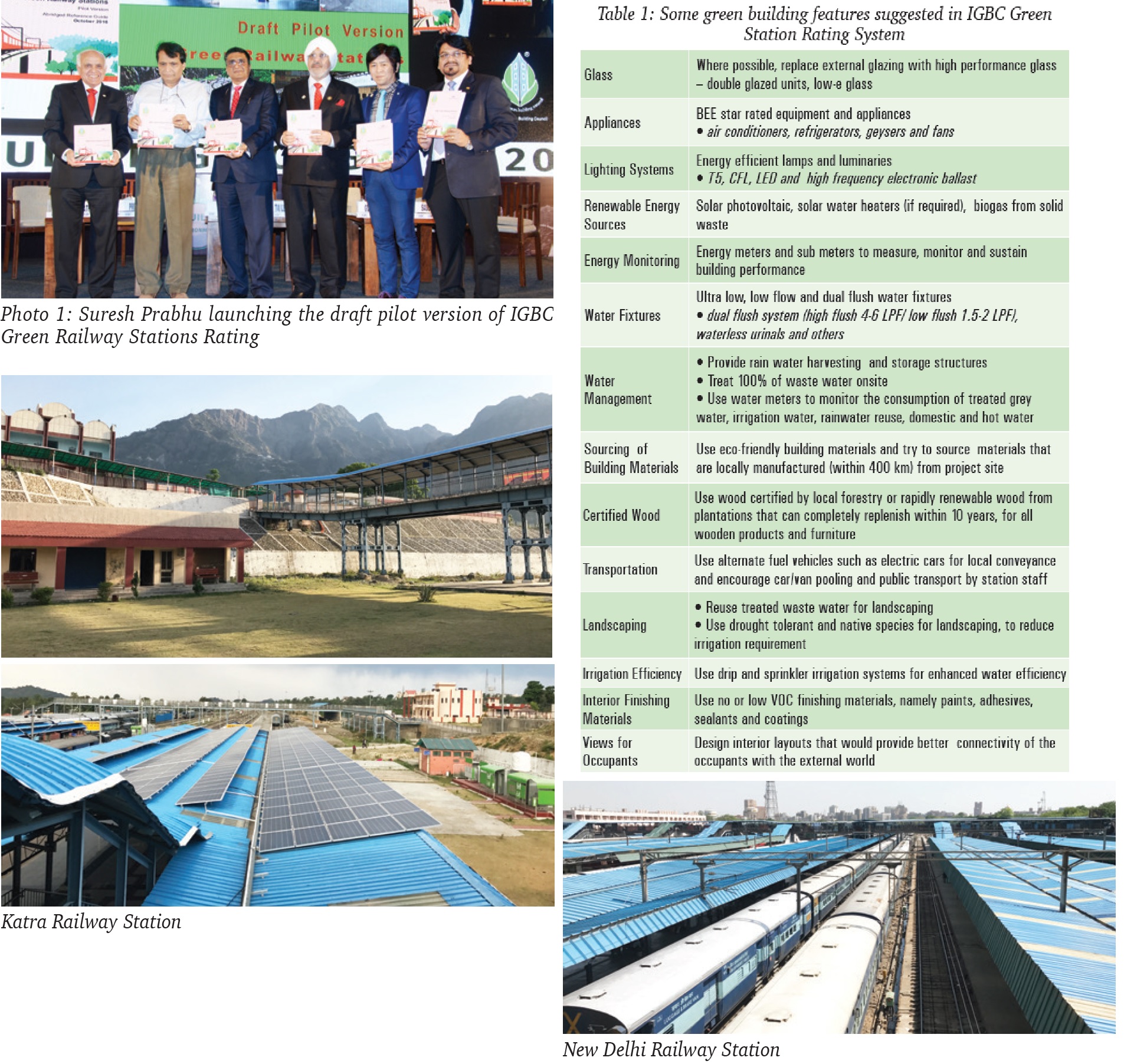Indian Railways have taken a number of policy initiatives to manage environmental resources. Some of these are: provision for environment related works in the schedule of rates for cost estimate for works; policy on formation of environmental management wing in zonal railways; plantation of trees alongside track and vacant land areas; LED based lighting in service applications and setting up of solar PV panels on the rooftop of railway buildings for on-site green power generation. Adoption of Green concepts at railway stations can significantly contribute towards reduction in environmental impact, while enhancing passenger awareness and experience. To implement Green concepts seamlessly across all the railway stations and monitor them on a continuous basis, there is a need for a comprehensive framework. Against this background, the Indian Green Building Council (IGBC), with the support of Environment Directorate of Indian Railways, has developed the IGBC Green Railway Stations Rating System. Suresh Prabhu, Minister of Railways, launched its draft pilot version at the Green Building Congress 2016 at Mumbai in October 2016. The objective of the Rating System is to facilitate adoption of Green concepts, thereby reducing the adverse environmental impact from station operation and maintenance, and enhancing the overall commuter experience. The Rating System would also facilitate bringing down the carbon footprint of stations and in the process make them greener and healthier.
Scope
Green Railway Stations Rating System is designed primarily for existing railway stations throughout our country.
Benefits of Green Approach in Railway Stations
Green stations can have tremendous benefits, both tangible and intangible. Some of the benefits are:
• Green and smart passenger amenities for enhanced comfort, better health and hygiene
• Improvement in resource efficiency by reducing power and fresh water demand
• Effective waste management
• Adoption of effective and efficient water management practices
• Increased use of renewable energy through solar PV panels.
• Enhanced commuter experience
• Improved health and well-being of the staff
The most tangible benefits are reduction in water and energy consumption. Energy savings could range from 20 to 30% and fresh water savings around 30 to 50%. Further,
effective water management practices will help in meeting the water requirements of nearby places facing water shortages. Intangible benefits of green stations include enhanced air quality, excellent daylighting, better comfort, health and well-being of passengers. Green Railway Station Rating System addresses the most important national priorities, which include water conservation, handling of solid waste, energy efficiency, reduced use of fossil fuels, lesser dependence on usage of virgin materials and health and well-being of citizens. The rating system requires the application of National standards and codes, such as NBC, ECBC, MoEF guidelines, CPCB guidelines and several others. The overarching objective of the Green Rating is to score higher than the National standards and create new benchmarks.
Promoting Energy Efficiency
Railway stations consume significant amounts of electrical energy. Green Railway Stations Rating System can help stations reduce energy consumption through energy efficient lighting, use of energy efficient appliances such as air conditioners and ventilation fans, extensive use of daylighting and other similar measures. The energy savings that can be realised by adopting this rating programcan be of the order of 20-30%.
Conservation Measures
1. Energy Efficient Lighting Fixtures: At least 50% of the lighting fixtures installed in the station’s non traction areas shall have LED lamps.
2. Lighting Controls: All non-emergency exterior and common area lighting, such as the façade, pathways, landscaping, surface and covered parking, street lighting and staircases, shall have at least one of the following controls:
• Daylight sensor
• Occupancy/motion sensor
• Timer
3. Energy Efficient Fans: At least 50% of fans installed in the station shall have a minimum BEE 3-star rating, or equivalent.
4. Energy Efficiency in Appliances and Equipment: At least 50% of computers, monitors and printers used in station office and booking office shall be with Energy Star rating or equivalent.
5. Energy Efficient Air Conditioners: All unitary air conditioners installed in the station shall be with a minimum BEE 3-star rating or equivalent.
6. Heating Systems: Stations in northern and north-eastern regions, having more than 150 heating degrees (HDD18), shall consider setting up heating system with a minimum COP of 2.5 (EER of 8.53).
7. Energy Efficient Pumps and Motors: All pumps and motors installed in the station shall be with a minimum BEE 3-star rating or equivalent.
New Delhi and Katra railway stations have been taken up as pilot projects under the Green Railway Stations rating program.
Conclusion
Green Railway Stations Rating System will go a long way towards enhancing passenger comfort and making journeys refreshing and memorable. This is turn will consolidate the position of Indian Railways as a ‘Green Transporter’, and in the process help build a greener and healthier India.
Disclaimer: The information provided within this publication / eBook/ content is for general informational purposes only. While we try to keep the information up-to-date and correct, there are no representations or warranties, express or implied, about the completeness, accuracy, reliability, suitability or availability with respect to the information, products, services, or related graphics contained in this publication / eBook/ content for any purpose. Any use of this information is at your own risk.
 Youth
Youth
 Women
Women
 Research for Ishrae
Research for Ishrae







